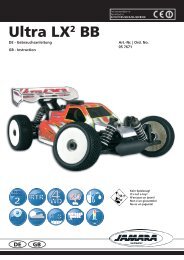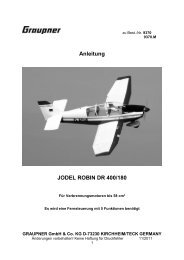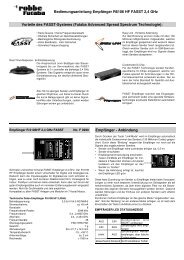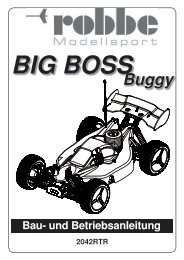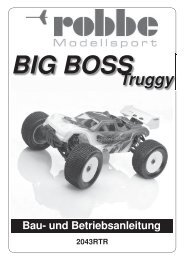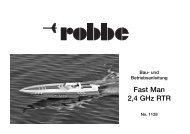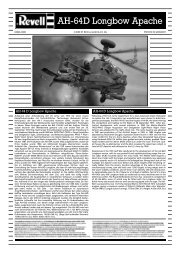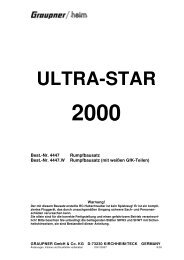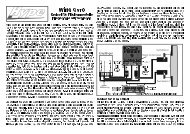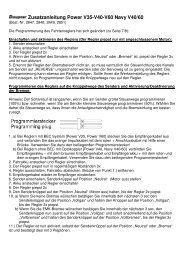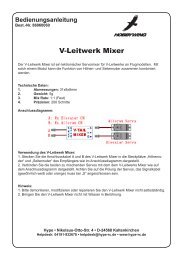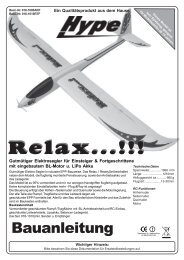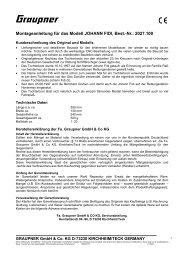PDF: WP Arkona Rettungskreuzer - CMC-Versand
PDF: WP Arkona Rettungskreuzer - CMC-Versand
PDF: WP Arkona Rettungskreuzer - CMC-Versand
Create successful ePaper yourself
Turn your PDF publications into a flip-book with our unique Google optimized e-Paper software.
Betriebsanleitung für das Modell ARKONA, Best.-Nr.: 2004<br />
Beschreibung des Originals<br />
Die <strong>Arkona</strong> wurde eingesetzt als Seenotrettungsboot bei dem ehemaligen Seenotrettungsdienst der DDR.<br />
Gebaut wurde die <strong>Arkona</strong> auf der polnischen Wisla-Werft im Jahr 1974 als Schwesterschiff der Typen der<br />
Halny Serie. Nach Übernahme der Seenotrettungsaufgabe im gesamten Ostseeraum durch die Deutsche<br />
Gesellschaft zur Rettung Schiffbrüchiger (DGzRS) und der Einsatz von modernen Kreuzern wurde die<br />
<strong>Arkona</strong> 1992 an den polnischen Rettungsdienst übergeben. Das Modell stellt den Zustand der letzten<br />
Einsatzjahre dar.<br />
Beschreibung des Modells<br />
Dieses Modell ist eins aus der GRAUPNER PREMIUM-Line, diese Serie von besonders hochwertigen<br />
Fertigmodellen, ist bisher in dieser Detaillierung auf dem Markt unerreicht.<br />
Um diese hochwertige Ausführung zu erreichen, ist der Rumpf aus stabilem GFK gefertigt, die Aufbauten<br />
und das Deck aus gelaserten ABS-Teilen sowie viele Kleinteile aus Metall gefertigt und schon vormontiert.<br />
Der Rumpf, Teile der Aufbauten, die Masten und die Beschlagteile sind mit seidenmatten Farben<br />
spritzlackiert und die Dekors aufgebracht. Dank der vielen Details und Beschlagteile wirkt das Modell<br />
besonders originalgetreu.<br />
Der Einbau der RC-Komponenten ist durch die große Öffnung im Deck einfach und schnell zu<br />
bewerkstelligen. Um das Modell fahrbereit zu machen, müssen nur die RC-Komponenten und der<br />
Fahrakku eingebaut sowie geringe Lötarbeiten ausgeführt werden, schon ist das Modell fahrbereit.<br />
Technische Daten<br />
Länge ca. 840mm<br />
Breite ca. 235mm<br />
Gesamthöhe ca. 610mm<br />
Gesamtgewicht mit RC ca. 4,5kg<br />
Maßstab ca. 1:25<br />
Wichtige Sicherheitshinweise<br />
Sie haben ein Modell erworben, aus dem – zusammen mit entsprechendem geeignetem Zubehör – ein<br />
funktionsfähiges RC-Modell fertiggestellt werden kann. Die Einhaltung der Montage- und<br />
Betriebsanleitung im Zusammenhang mit dem Modell sowie die Installation, der Betrieb, die Verwendung<br />
und Wartung der mit dem Modell zusammenhängenden Komponenten können von GRAUPNER nicht<br />
überwacht werden. Daher übernimmt GRAUPNER keinerlei Haftung für Verluste, Schäden oder Kosten,<br />
die sich aus dem fehlerhaften Betrieb, aus fehlerhaftem Verhalten bzw. in irgendeiner Weise mit dem<br />
vorgenannten zusammenhängend ergeben. Soweit vom Gesetzgeber nicht zwingend vorgeschrieben, ist<br />
die Verpflichtung der Firma GRAUPNER zur Leistung von Schadensersatz, aus welchem Grund auch<br />
immer ausgeschlossen (inkl. Personenschäden, Tod, Beschädigung von Gebäuden sowie auch Schäden<br />
durch Umsatz- oder Geschäftsverlust, durch Geschäftsunterbrechung oder andere indirekte oder direkte<br />
Folgeschäden), die von dem Einsatz des Modells herrühren.<br />
Die Gesamthaftung ist unter allen Umständen und in jedem Fall beschränkt auf den Betrag, den Sie<br />
tatsächlich für dieses Modell gezahlt haben.<br />
Die Inbetriebnahme und der Betrieb des Modells erfolgt einzig und allein auf Gefahr des<br />
Betreibers. Nur ein vorsichtiger und überlegter Umgang beim Betrieb schützt vor Personen- und<br />
Sachschäden.<br />
Prüfen Sie vor dem ersten Einsatz des Modells, ob Ihre Privat-Haftpflichtversicherung den Betrieb von<br />
Modellschiffen dieser Art mit einschließt. Schließen Sie gegebenenfalls eine spezielle RC-Modell-<br />
Haftpflichtversicherung ab.<br />
Diese Sicherheitshinweise müssen unbedingt aufbewahrt werden und müssen bei einem Weiterverkauf<br />
des Modells an den Käufer weitergegeben werden.<br />
GRAUPNER GmbH & Co. KG D-73230 KIRCHHEIM/TECK GERMANY<br />
Keine Haftung für Druckfehler. Technische Änderungen vorbehalten! Liability for printing errors excluded. We reserve the right to introduce modifications. Sous réserve de<br />
modifications! Nous ne sommes pas responsables d’éventuelles erreurs d’impression! #0056902 08/2006<br />
1
Garantiebedingungen<br />
Die Garantie besteht aus der kostenlosen Reparatur bzw. dem Umtausch von solchen Teilen, die<br />
während der Garantiezeit von 24 Monaten, ab dem Datum des Kaufes nachgewiesene Fabrikations- oder<br />
Materialfehler aufweisen. Weitergehende Ansprüche sind ausgeschlossen. Transport-, Verpackungs- und<br />
Fahrtkosten gehen zu Lasten des Käufers. Für Transportschäden wird keine Haftung übernommen. Bei<br />
der Einsendung an GRAUPNER bzw. an die für das jeweilige Land zuständige Servicestelle sind eine<br />
sachdienliche Fehlerbeschreibung und die Rechnung mit dem Kaufdatum beizufügen. Die Garantie ist<br />
hinfällig, wenn der Ausfall des Teils oder des Modells von einem Unfall, unsachgemäßer Behandlung oder<br />
falscher Verwendung herrührt.<br />
Folgende Punkte müssen unbedingt beachtet werden:<br />
• Das Modell ist nicht für Kinder unter 14 Jahren geeignet.<br />
• Die hervorstehenden Teile an dem Modell können scharf sein und die Antennen bzw. Masten können<br />
Augenverletzungen hervorrufen.<br />
• Beachten Sie beim Einsatz von Werkzeugen die möglichen Gefahren durch diese.<br />
• Das Modell vorsichtig betreiben, wenn sich Menschen und Tiere im Wasser befinden. Halten Sie<br />
immer ausreichend Abstand zu den Menschen bzw. Tieren.<br />
• Lassen Sie Ihr Modell nicht in Naturschutz-, Landschaftsschutz-, oder Gewässerschutzgebieten<br />
fahren. Informieren Sie sich bei Ihrer Gemeinde über die für den Schiffsmodellbau freigegebenen<br />
Gewässer.<br />
• Fahren Sie niemals im Salzwasser.<br />
• Fahren Sie niemals bei widrigen Witterungsbedingungen, wie z.B. Regen, Gewitter, stärkerem Wind<br />
sowie höherem Wellengang, Strömung des Gewässers usw..<br />
• Beachten Sie die Empfehlungen und Hinweise zu Ihrer Fernsteuerung und Zubehörteilen.<br />
• Kontrollieren Sie, bevor Sie das Modell fahren lassen, dieses auf eine sichere Funktion der<br />
Fernsteuerung sowie die Steckverbindungen auf sichere und feste Verbindung.<br />
• Trockenbatterien zur Stromversorgung dürfen niemals nachgeladen werden. Nur Akkus dürfen<br />
nachgeladen werden.<br />
• Die Reichweite der Fernsteuerung muss vor Fahrtbeginn überprüft worden sein. Laufen Sie hierzu mit<br />
eingeschaltetem Modell ca. 50m vom Sender weg, ein Helfer bedient währenddessen den Sender.<br />
Hierbei müssen alle Funktionen problemlos ausgeführt werden können.<br />
• Prüfen Sie, ob der von Ihnen genutzte Kanal frei ist. Fahren Sie niemals, wenn Sie sich nicht sicher<br />
sind, ob der Kanal frei ist.<br />
• Beachten Sie, dass Funkgeräte oder Sendeanlagen die Funktion des Modells stark stören können.<br />
Achten Sie möglichst darauf, dass keines dieser Geräte in der Nähe betrieben wird während Sie das<br />
Modell betreiben.<br />
• Arbeiten Sie nur an den Antriebsteilen, wenn der Fahrakku nicht angeschlossen ist.<br />
• Bei angeschlossenem Fahrakku dürfen Sie und andere Personen niemals in den Bereich der<br />
Schiffsschrauben kommen.<br />
• Die empfohlene Betriebsspannung nicht übersteigen. Eine höhere Spannung kann zum Überhitzen<br />
der Motoren bzw. des Fahrtreglers führen oder die elektrischen Leitungen können durchschmoren.<br />
Dadurch kann das Modell zerstört werden.<br />
• Achten Sie auf Leichtläufigkeit aller Antriebskomponenten. Dies gilt besonders während des<br />
Fahrbetriebs, da sich Blätter und andere Dinge im Antrieb verfangen können. In einem solchen Fall<br />
können die Motoren bzw. der Fahrtregler durch Überlast zerstört werden.<br />
• Die Batterien und Akkus dürfen nicht kurzgeschlossen werden, sowie nicht direkt dem Wasser<br />
ausgesetzt werden.<br />
• Entnehmen Sie den Akku und die Sender- und Empfängerbatterien beim Nichtgebrauch des Modells.<br />
• Setzen Sie das Modell nicht starker Luftfeuchtigkeit, Hitze, Kälte sowie Schmutz aus.<br />
• Sichern Sie das Modell und den Sender beim Transport gegen Beschädigung sowie Verrutschen.<br />
• Betreiben Sie niemals das Modell an einem stark bewegten Wasser (z.B. Fluss), da bedingt durch die<br />
relativ geringe Geschwindigkeit das Modell abtreiben kann.<br />
• Bringen Sie bei einer evtl. Bergung des Modells sich nicht selbst sowie andere in Gefahr.<br />
• Achten Sie besonders auf die Wasserdichtheit des Modells. Ein Modellboot wird bei entsprechendem<br />
Wassereinbruch sinken. Kontrollieren Sie das Modell vor jeder Fahrt, ob irgendeine Beschädigung<br />
vorliegt und ob Wasser durch die Antriebe bzw. die Ruderwellen eindringen kann.<br />
• Lassen Sie das Modell nach Gebrauch gut austrocknen.<br />
• Kontrollieren Sie unbedingt während der ersten Fahrt mehrmals, ob die Wellenanlage wasserdicht ist.<br />
Wenn Wasser eindringt, demontieren Sie die Wellen und schmieren die Stevenrohre mit ausreichend<br />
Fett (Best.-Nr. 570) nach.<br />
GRAUPNER GmbH & Co. KG D-73230 KIRCHHEIM/TECK GERMANY<br />
Keine Haftung für Druckfehler. Technische Änderungen vorbehalten! Liability for printing errors excluded. We reserve the right to introduce modifications. Sous réserve de<br />
modifications! Nous ne sommes pas responsables d’éventuelles erreurs d’impression! #0056902 08/2006<br />
2
• HINWEIS: da das Modell aus Sicherheitsgründen leicht übermotorisiert ist, darf mit den empfohlenen<br />
Akkus KEIN Dauervollgas gefahren werden. Die Fahrmotoren werden sonst zu heiß und könnten<br />
dabei beschädigt oder zerstört werden. Fahren Sie daher vorbildgetreu langsamer oder max. 10<br />
Minuten mit Vollgas. Lassen Sie die Motoren zwischendurch immer etwas abkühlen.<br />
Pflege und Wartung<br />
• Säubern Sie das Modell nach jedem Gebrauch. Entfernen Sie evtl. eingedrungenes Wasser. Sollte<br />
Wasser in die RC-Komponenten gedrungen sein, legen Sie diese trocken und schicken Sie das<br />
Modell zur Kontrolle an die zuständige GRAUPNER Servicestelle ein.<br />
• Säubern Sie das Modell und den Sender nur mit geeigneten Reinigungsmitteln. Geeignet ist ein<br />
fusselfreies Tuch. Verwenden Sie niemals chemische Reiniger, Lösungsmittel, Reinigungsbenzin,<br />
Spiritus oder ähnliches.<br />
• Schmieren Sie die Antriebswellen nach Ende des Betriebs mit einem kleinen Tropfen Öl an den<br />
Lagern ab. Verwenden Sie zum Schmieren der Antriebe nur Öl, welches das Wasser nicht gefährdet<br />
bzw. verschmutzt (z.B. Best.-Nr. 206). Nach Ende der Fahrsaison sollten die Wellen demontiert<br />
werden und mit wasserneutralem Fett (z.B. Best.-Nr. 570) neu abgeschmiert werden.<br />
Montageanleitung<br />
• Packen Sie das Modell und den Schiffsständer<br />
vorsichtig aus.<br />
• Öffnen Sie das Modell, um die RC-Anlage<br />
einbauen zu können, müssen Sie den Aufbau<br />
vorsichtig nach oben abnehmen. Achten Sie<br />
darauf, dabei keine Beschlagteile abzubrechen.<br />
Um die Luke für die Wartung der Ruderanlage<br />
öffnen zu können, drücken Sie diese vorsichtig<br />
von innen auf.<br />
• Löten Sie an die Motoren einen G2-Stecker an.<br />
Die Motoren werden parallel und gegenläufig<br />
angeschlossen. Richten Sie sich nach dem<br />
folgenden Schaltplan (+ ist rot, - ist schwarz).<br />
Achten Sie auf die Drehrichtung der Motoren,<br />
wenn der Akku angeschlossen ist, sollen die<br />
Antriebe so drehen, dass das Modell vorwärts<br />
fahren würde. HINWEIS: Die Polung des G2-<br />
Steckersystem ist so ausgelegt, dass die Noppe<br />
auf dem Plastikgehäuse immer der Pluspol (rot)<br />
ist. Wenn man sich konsequent an diese Vorgabe<br />
hält, sind Akkus und Fahrtregler untereinander<br />
austauschbar und das System ist<br />
verpolungssicher.<br />
• Kontrollieren Sie die Schrauben der<br />
Wellenkupplung und der Propeller auf einen<br />
festen Sitz, da durch den Transport diese sich<br />
evtl. gelockert haben können. Ziehen Sie die<br />
dann wieder vorsichtig fest. WICHTIG: sichern<br />
Sie die evtl. lockeren Madenschrauben mit<br />
Schraubensicherungslack, z.B. UHU<br />
schraubensicher (Best.-Nr. 952), da diese sich<br />
durch Vibrationen während des Betriebs lösen<br />
könnten.<br />
• Löten Sie das Anschlusskabel an den Fahrakku<br />
sowie eine G2-Buchse an. HINWEIS: isolieren<br />
Sie die Lötstellen am Akku mit<br />
Schrumpfschlauch, Isolierband reicht aber auch<br />
zum Isolieren der Anschlüsse.<br />
• Stecken Sie auf das Ruderservo die beim Servo<br />
mitgelieferten Gummilager und stecken von unten<br />
die Messinghülsen in die Öffnungen in den Lagern. Stecken Sie das Servo in die Öffnung, bohren Sie<br />
durch die Befestigungslöcher mit einem Ø1,5mm Bohrer und drehen dann die Schrauben ein.<br />
GRAUPNER GmbH & Co. KG D-73230 KIRCHHEIM/TECK GERMANY<br />
Keine Haftung für Druckfehler. Technische Änderungen vorbehalten! Liability for printing errors excluded. We reserve the right to introduce modifications. Sous réserve de<br />
modifications! Nous ne sommes pas responsables d’éventuelles erreurs d’impression! #0056902 08/2006<br />
3
WICHTIG: darauf achten, dass das<br />
•<br />
Servoanschlusskabel nicht beschädigt wird.<br />
Bohren Sie in dem Servohebel das mittlere Loch<br />
mit einem Ø2mm Bohrer auf und schrauben<br />
einen Gestängeanschluss dort ein. Montieren<br />
Sie den Servohebel auf das mittig eingestellte<br />
Servo. Schrauben sie dann das Rudergestänge<br />
bei mittig eingestellten Ruder fest (siehe Foto).<br />
• Montieren Sie mit Klettband oder<br />
•<br />
doppelseitigem Klebeband den Fahrtregler in<br />
der Nähe der Motoren und den Empfänger<br />
neben des Servos im Rumpf.<br />
Schließen Sie das Servo und den Regler an den<br />
Empfänger an.<br />
• Verlegen Sie die Antenne unterhalb des<br />
Decksauflagerahmen im Rumpf und kleben Sie<br />
diese mit Klebeband fest. WICHTIG: um einen<br />
sicheren Empfang zu gewährleisten, muss das<br />
Antennenkabel möglichst weit über der<br />
Wasserlinie liegen und sollte ringförmig um den<br />
Rumpf laufen! Der GFK-Rumpf behindert den<br />
Empfang nur sehr minimal. Nach eigenem<br />
Ermessen kann auch eine Stabantenne aus<br />
dünnem Draht angebracht werden, dann muss<br />
das Antennenkabel um die Länge der<br />
Stabantenne gekürzt werden.<br />
• Montieren Sie auf dem Aufbau die drei<br />
Antennen und die Peilantenne auf der<br />
Mastspitze. Die Antennen werden mit<br />
Sekundenkleber verklebt. Die Antennen Nr.2<br />
kommen beidseitig auf die kleinen Konsolen.<br />
• Legen Sie den Akku in das Modell und testen<br />
Sie die Funktionen. Um die richtige Wasserlage<br />
(Trimmung) zu erreichen, müssen Sie den<br />
Fahrakku verschieben. Der Akku muss für den<br />
Fahrbetrieb fest fixiert werden, damit er nicht<br />
rutschen kann. Dies sollte an den Ecken des<br />
Akkus mit Klettband gemacht werden. TIPP: um<br />
später leicht wieder die richtige Position für den<br />
Schwerpunkt zu finden, markieren Sie mit einem<br />
Stift die Ecken des Akkus. HINWEIS: auf<br />
Wunsch kann auch ein Fahrakku mit höherer<br />
Kapazität eingesetzt werden (Best.-Nr. 768).<br />
GRAUPNER GmbH & Co. KG D-73230 KIRCHHEIM/TECK GERMANY<br />
Keine Haftung für Druckfehler. Technische Änderungen vorbehalten! Liability for printing errors excluded. We reserve the right to introduce modifications. Sous réserve de<br />
modifications! Nous ne sommes pas responsables d’éventuelles erreurs d’impression! #0056902 08/2006<br />
4
Schaltplan<br />
Motor<br />
Motor<br />
zum Fahrtregler<br />
Fahrtregler<br />
G2 Stecker G2 Stecker<br />
zum Empfänger<br />
Fahrakku<br />
zum Fahrakku<br />
Jungfernfahrt<br />
Laden Sie alle Akkus und testen Sie die Funktionen des Modells. Kontrollieren Sie, ob alle aufgesteckten<br />
Teile fest sitzen. Nun können Sie die Jungfernfahrt starten. Lassen Sie es bei der Jungfernfahrt langsam<br />
angehen, machen Sie sich erst mit dem Fahrverhalten vertraut. Fahren Sie nicht zu weit weg vom Ufer.<br />
Viel Spaß beim Fahren mit Ihrem Modell ARKONA.<br />
Ersatzteile<br />
Best.-Nr. 2004.6 Schiffsschraubensatz<br />
Ferner wird benötigt (nicht im Lieferumfang enthalten)<br />
Best.-Nr. 4709 RC-Set ECO-SPORT-SYSTEM X-306 FM<br />
Best.-Nr. 2875 Fahrtregler NAVY V40R<br />
Best.-Nr. 775 Fahrakku Bleibatterie 6V 7Ah<br />
oder<br />
Best.-Nr. 768 Fahrakku Bleibatterie 6V 10Ah<br />
Best.-Nr. 2989 G2-Steckersystem zum Anschluss des Fahrtreglers und Akku<br />
Best.-Nr. 3389 2m Kupferlitze<br />
Best.-Nr. 1177 Gestängeanschluss<br />
Best.-Nr. 3368.1 Klettband<br />
GRAUPNER GmbH & Co. KG D-73230 KIRCHHEIM/TECK GERMANY<br />
Keine Haftung für Druckfehler. Technische Änderungen vorbehalten! Liability for printing errors excluded. We reserve the right to introduce modifications. Sous réserve de<br />
modifications! Nous ne sommes pas responsables d’éventuelles erreurs d’impression! #0056902 08/2006<br />
5
Operating instructions for the ARKONA model boat, Order No.: 2004<br />
The full-size vessel<br />
The <strong>Arkona</strong> was employed as an ocean-going boat by the marine rescue service of the former GDR (East<br />
Germany). The vessel was built at the Polish Wisla dockyard in 1974 as sister-ship of the Halny series. In<br />
1992 the German Association for the Rescue of the Shipwrecked (DGzRS) accepted sea rescue<br />
responsibility for the entire Baltic region, and introduced modern cruisers to the fleet; at this point the<br />
<strong>Arkona</strong> was transferred to the Polish rescue service. This model represents the state of the vessel in its<br />
final years of service.<br />
The model<br />
This boat expands the GRAUPNER PREMIUM line, a series of particularly high-quality ready-made<br />
models with an unprecedented level of detailing.<br />
The core of this high-quality model is the robust moulded GRP hull, complemented by the superstructure<br />
and deck which are constructed from laser-cut ABS parts. Many of the small items are of metal, and<br />
almost everything is factory-assembled. The hull, some parts of the superstructure, the masts and fittings<br />
are spray-finished using semi-matt paints, and the decals are already applied. The many details and scale<br />
fittings give the boat an impressive scale appearance.<br />
The large deck opening makes it a simple matter to install the RC components, and the procedure is<br />
quickly completed. To prepare the boat for running all you have to do is install the RC components and the<br />
drive battery, carry out a little soldering, and the model is ready for the water.<br />
Specification<br />
Overall length approx. 840 mm<br />
Beam approx. 235 mm<br />
Overall height approx. 610 mm<br />
All-up weight incl. RC approx. 4.5 kg<br />
Scale approx. 1 : 25<br />
Important safety notes<br />
You have acquired a kit which can be assembled into a fully working RC model when fitted out with<br />
suitable accessories. However, we as manufacturers have no control over the way you build and operate<br />
your RC model boat, nor how you install, operate and maintain the associated components, and for this<br />
reason we are obliged to deny all liability for loss, damage or costs which are incurred due to the<br />
incompetent or incorrect use and operation of our products, or which are connected with such operation in<br />
any way. Unless otherwise prescribed by binding law, the obligation of the GRAUPNER company to pay<br />
compensation, regardless of the legal argument employed, is excluded. This includes personal injury,<br />
death, damage to buildings, damage due to loss of business or turnover, interruption of business or other<br />
direct or indirect consequent damage whose root cause was the operation of the model.<br />
The total liability in all cases is limited to the amount of money which you actually paid for this model.<br />
This model boat is built and operated at the sole and express responsibility of the operator. The<br />
only way to avoid injury to persons and damage to property is to handle and operate the model<br />
with the greatest care and consideration at all times.<br />
Before you run the model for the first time please check that your private third-party<br />
insurance covers the operation of model boats of this kind. If in doubt, take out a special<br />
insurance policy designed to cover modelling risks.<br />
These safety notes should be kept in a safe place. If you ever dispose of the model, be<br />
sure to pass them on to the new owner.<br />
GRAUPNER GmbH & Co. KG D-73230 KIRCHHEIM/TECK GERMANY<br />
Keine Haftung für Druckfehler. Technische Änderungen vorbehalten! Liability for printing errors excluded. We reserve the right to introduce modifications. Sous réserve de<br />
modifications! Nous ne sommes pas responsables d’éventuelles erreurs d’impression! #0056902 08/2006<br />
6
Guarantee conditions<br />
The guarantee covers replacement of any parts which can be shown to exhibit manufacturing faults or<br />
material defects within the guarantee period of 24 months from the initial date of purchase. No other<br />
claims will be considered. Cost of transport, packing and freight are payable by the purchaser. We accept<br />
no liability for damage in transit. When you send the product to GRAUPNER, or to the approved Service<br />
Centre for your country, you must include a clear and concise description of the fault together with the<br />
invoice showing the date of purchase. The guarantee is invalid if the component or model fails due to an<br />
accident, incompetent handling or incorrect usage.<br />
The following points are important and must be observed at all times:<br />
• This model is not suitable for young persons under 14 years of age.<br />
• The projecting parts of the model may be sharp, and the aerials and masts could cause eye injuries.<br />
• Bear in mind that tools can be dangerous; always be careful when handling them.<br />
• Operate the model carefully when there are persons or animals in the water, and always keep a safe<br />
distance away from people and animals.<br />
• Never run your model in protected sites, animal or plant sanctuaries or sites of special scientific<br />
interest (SSSIs). Check with your local authority that the stretch of water you wish to use is suitable for<br />
model boats.<br />
• Never run the boat in salt water<br />
• Never run the boat in adverse conditions, e.g. rain, storm, strong wind, choppy water or strong<br />
currents.<br />
• Read the instructions provided with your radio control system and accessories, and observe the<br />
recommendations.<br />
• Before you run the model check that the radio control system is working reliably, and that all<br />
connections are secure.<br />
• The dry batteries must never be recharged. Only batteries marked as “rechargeable” are safe to<br />
recharge.<br />
• Check the range of the radio control system before each session: ask a friend to walk about 50 m<br />
away from the model carrying the transmitter. Your friend will be able to tell you whether all the<br />
working functions operate correctly at this range.<br />
• Ensure that the frequency you intend to use is not already in use by other modellers. Never run your<br />
boat if you are not certain that your channel is free.<br />
• Bear in mind that other radio equipment and transmitting stations can cause serious interference to<br />
the model. Ensure that no equipment of this type is being used in the vicinity while you are operating<br />
the model.<br />
• Do not carry out any work on the drive train unless you have disconnected and removed the battery.<br />
• When the drive battery is connected, keep well clear of the area around the propellers. Make sure any<br />
spectators do the same.<br />
• Do not be tempted to exceed the recommended operating voltage. Higher voltages may cause the<br />
motors or speed controller to overheat, and the electrical cables may even melt. If this should happen,<br />
the model could easily be ruined.<br />
• Check that all the drive train components work smoothly and freely. This applies in particular when the<br />
boat is running, as leaves and other debris may get caught in the power system components. The<br />
motor and speed controller could then be ruined by overloading.<br />
• Dry cells and rechargeable batteries must never be short-circuited. Do not allow them to come into<br />
direct contact with water.<br />
• Remove the rechargeable battery and the dry cells in the transmitter and receiver pack if the model is<br />
to be transported, or will not be used for a long period.<br />
• Do not subject the model boat to high levels of humidity, heat, cold or dirt.<br />
• Secure the model and your RC equipment carefully when transporting them. They may be seriously<br />
damaged if they are free to slide about.<br />
• Never operate the boat in moving water (e.g. a river), as its low speed may result in the model drifting<br />
off downstream.<br />
• If you have to salvage the model, take care not to risk your own life or that of others.<br />
• Take particular care to ensure that the boat is completely watertight, as it will sink if too much water<br />
enters the hull. Check the model for damage before every run, and ensure that water cannot penetrate<br />
through the shaft bearings.<br />
• Allow the boat to dry out thoroughly after each session.<br />
• Be sure to check repeatedly during the first run that the shaft system is watertight. If water enters the<br />
hull through the shaft tubes, remove the shafts and lubricate the tubes with plenty of grease, Order<br />
GRAUPNER GmbH & Co. KG D-73230 KIRCHHEIM/TECK GERMANY<br />
Keine Haftung für Druckfehler. Technische Änderungen vorbehalten! Liability for printing errors excluded. We reserve the right to introduce modifications. Sous réserve de<br />
modifications! Nous ne sommes pas responsables d’éventuelles erreurs d’impression! #0056902 08/2006<br />
7
No. 570.<br />
• NOTE: in the interests of safety the boat has a slight excess of power. This means that it is NOT<br />
permissible to run the vessel at full power if the recommended batteries are fitted, as the drive motors<br />
will overheat and could be damaged or even ruined. We recommend that you run the boat at scale<br />
(i.e. reduced) speed, or run it for no longer than ten minutes at full-throttle. Allow the motors to cool<br />
down between periods of high-speed running.<br />
Care and maintenance<br />
• Clean the model carefully after every run, and remove any water which penetrates the hull. If water<br />
gets into the RC components, dry them out carefully and send them to your nearest GRAUPNER<br />
Service Centre for checking.<br />
• Clean the model and transmitter using suitable cleaning agents only. All you need is a lint-free cloth.<br />
Never use chemical cleaners, solvents, methylated spirits, white spirit or similar.<br />
• Lubricate the propeller shafts at regular intervals by applying a small drop of oil to the bearings. Use a<br />
type of oil which does not soil or contaminate water, e.g. Order No. 206. At the end of the season we<br />
recommend that you remove the propeller shaft and re-lubricate it using water-neutral grease, Order<br />
No. 570.<br />
Assembling the model<br />
• Carefully unpack the model and the boatstand.<br />
• Carefully lift off the superstructure to open the<br />
deck, so that the receiving system can be<br />
installed. Take care not to break off any fittings.<br />
Locate the hatch which provides access to the<br />
rudder system for maintenance, and press it out<br />
carefully from the inside.<br />
• Remove the motors by loosening the clamps<br />
which hold them in place, and undo the shaft<br />
couplings at the motor end. Solder G2 plugs to<br />
the wires attached to the motors, then re-install<br />
the motors in the hull. The motors are wired in<br />
parallel, and spin in opposite directions (contra-<br />
•<br />
•<br />
•<br />
rotating propellers). Keep to the arrangement<br />
shown in the wiring diagram (+ is red, - is black).<br />
NOTE: the raised lug on the plastic housing of all<br />
G2 connectors should always be the positive<br />
terminal (red wire). If you keep consistently to this<br />
principle, your batteries and speed controllers will<br />
be interchangeable, and the system will be<br />
protected against accidental reversed polarity.<br />
Check that the propellers and the screws in the<br />
shaft couplings are tight, as they may have come<br />
loose in transit; re-tighten them if necessary.<br />
Solder the connecting wires to the drive battery<br />
terminals, and solder a G2 socket to the other<br />
end. TIP: in the photo the solder joints are shown<br />
insulated with pieces of heat-shrink tubing,<br />
but<br />
insulating tape is also perfectly adequate.<br />
Press the rubber grommets into the mounting<br />
lugs of the rudder servo, and push the brass<br />
sleeves through them from the underside. Fix the<br />
servo in the model using the retaining screws<br />
supplied. Set the servo to centre from the<br />
transmitter, and fit the output arm on the servo<br />
output shaft. Open up the centre hole in one arm<br />
of the servo output lever using a 2 mm Ø drill, and<br />
install a swivel pushrod connector. Set the servo<br />
to centre and fit the output arm on the servo<br />
output shaft.<br />
GRAUPNER GmbH & Co. KG D-73230 KIRCHHEIM/TECK GERMANY<br />
Keine Haftung für Druckfehler. Technische Änderungen vorbehalten! Liability for printing errors excluded. We reserve the right to introduce modifications. Sous réserve de<br />
modifications! Nous ne sommes pas responsables d’éventuelles erreurs d’impression! #0056902 08/2006<br />
8
• Set the rudder to centre and tighten the rudder<br />
arm as shown in the photo.<br />
Set the servo to<br />
centre from the transmitter, and fit the output arm<br />
on the servo output shaft.<br />
• Attach Velcro (hook-and-loop) tape or double-<br />
sided foam tape to the speed controller and the<br />
receiver and install<br />
them on the RC plate.<br />
• Connect the rudder servo and the speed controller<br />
to the receiver.<br />
• Deploy the receiver aerial under the deck support<br />
flange inside the hull, and tape it in place securely.<br />
IMPORTANT: to ensure reliable reception, the<br />
aerial wire must be as high as possible above the<br />
waterline, and should run in a broad curve round<br />
the hull; the GRP hull only has a very slight<br />
adverse effect on radio reception. However, you<br />
can install a vertical whip aerial made of thin wire,<br />
if you prefer. If you do this, shorten the flexible<br />
aerial attached to the receiver by the same length<br />
as the whip, then solder the two together.<br />
• Fit the funnel mast and the three aerials to the<br />
superstructure. The mast<br />
is screwed in place from<br />
underneath, while the aerials can be fixed in place<br />
with a drop of cyano.<br />
• Place the battery in the model and check the<br />
working systems. You will need to adjust the<br />
position of the drive battery to obtain the correct<br />
trim - the boat should float at the marked waterline.<br />
The battery must be fixed securely, so that it<br />
cannot slip out of position. You can use Velcro<br />
(hook-and-loop) tape for this. TIP: mark the<br />
position of the corners of the battery using a felt-tip<br />
pen, so that you can replace it in exactly the same<br />
position every time. NOTE: a drive battery of<br />
higher capacity (Order No. 768) can also be<br />
installed if you wish.<br />
GRAUPNER GmbH & Co. KG D-73230 KIRCHHEIM/TECK GERMANY<br />
Keine Haftung für Druckfehler. Technische Änderungen vorbehalten! Liability for printing errors excluded. We reserve the right to introduce modifications. Sous réserve de<br />
modifications! Nous ne sommes pas responsables d’éventuelles erreurs d’impression! #0056902 08/2006<br />
9
Wiring diagram<br />
Motor<br />
Motor<br />
to speed controller<br />
speed controller<br />
G2 plug G2 plug<br />
to receiver<br />
Drive battery<br />
to battery<br />
Maiden run<br />
Charge up the batteries and check each working system in turn. Ensure that all the loose parts are<br />
secured well. Now you are ready for the boat’s maiden run. Keep the speed down initially until you feel<br />
familiar with the model’s handling characteristics. Don’t allow the boat to get too far away from the bank.<br />
We hope you have many hours of pleasure assembling and running your ARKONA model boat.<br />
Replacement parts<br />
Order No. 2004.6 Propeller set<br />
You will also need the following items (not included in the set)<br />
Order No. 4709 X-306 ECO-SPORT FM RC set<br />
Order No. 2875 NAVY V40R speed controller<br />
Order No. 775<br />
or<br />
Lead-acid drive battery, 6 V / 7 Ah<br />
Order No. 768 Lead-acid drive battery, 6 V / 10 Ah<br />
Order No. 2989 G2 connector system for speed controller and battery<br />
Order No. 3389 2 m flexible copper cable; alternatively you can shorten the cables attached to the motor<br />
and use this material for the connecting leads to the drive battery<br />
Order No. 3368.1 Velcro tape<br />
Order No. 1177 Swivel pushrod connector<br />
GRAUPNER GmbH & Co. KG D-73230 KIRCHHEIM/TECK GERMANY<br />
Keine Haftung für Druckfehler. Technische Änderungen vorbehalten! Liability for printing errors excluded. We reserve the right to introduce modifications. Sous réserve de<br />
modifications! Nous ne sommes pas responsables d’éventuelles erreurs d’impression! #0056902 08/2006<br />
10
Instructions d’utilisation pour le modèle ARKONA, Réf. N°2004<br />
Description de l’original<br />
L’<strong>Arkona</strong> a été engagé dans les anciens services de sauvetage en mer de la DDR. L’<strong>Arkona</strong> a été<br />
construit dans les Chantiers Polonais Wisla-Werft en 1974 comme bateau de même catégorie dans la<br />
série des types Halny. Après la reprise des missions de sauvetage en mer dans la totalité du secteur de la<br />
mer Baltique par la Société Allemande de sauvetage des navires naufragés(DGzRS) et la mise en service<br />
de croiseurs modernes, l’<strong>Arkona</strong> a été remis aux services de sauvetage Polonais en 1992. Le modèle<br />
représente l’état de l’<strong>Arkona</strong> dans sa dernière année de service<br />
Description du modèle<br />
Ce modèle fait partie de la PREMIUM-Line GRAUPNER, cette série de modèles finis d’une très haute<br />
qualité dont le super détaillage n’a jamais été atteint jusqu’alors.<br />
Pour obtenir cette exécution de haute qualité, la coque est en solide fibre de verre, les superstructures et<br />
le pont sont des pièces en bois et en ABS découpées au Laser et les nombreuses petites pièces<br />
fabriquées en métal sont déjà montées. La coque, les superstructures, les mâts st les pièces<br />
d’accastillage dont peintes au pistolet avec des peintures satinées et la décoration est posée. Grâce aux<br />
nombreux détails et aux pièces d’accastillage, ce modèle est particulièrement réaliste.<br />
Le montage de l’équipement R/C est facile et rapide à effectuer grâce à la grande ouverture dans le pont.<br />
Pour mettre le modèle en ordre de navigation, il suffit d’installer les éléments R/C et l’accu de propulsion<br />
ainsi qu’à effectuer quelques petits travaux de soudure.<br />
Caractéristiques techniques<br />
Longueur, env. 840mm<br />
Largeur, env. 235mm<br />
Hauteur totale, env. 610mm<br />
Poids total avec R/C, env. 4,5 Kg.<br />
Echelle de reproduction, env. 1:25<br />
Conseils de sécurité importants<br />
Vous avez fait l'acquisition d'un modèle avec les accessoires correspondants qui vont vous permettre la<br />
réalisation d'un bateau radiocommandé. Le respect des instructions de montage et d'utilisation relatives<br />
au modèle ainsi que l'installation, l'utilisation et l'entretien des éléments de son équipement ne peuvent<br />
pas être surveillés par la Firme GRAUPNER. C'est pourquoi nous déclinons toute responsabilité<br />
concernent les pertes, les dommages ou les coûts résultants d'une mauvaise utilisation ou d'un<br />
fonctionnement défectueux. Tant qu'elle n'y a pas été contrainte par le législateur, la responsabilité de la<br />
Firme GRAUPNER n'est aucunement engagée pour les dédommagements (incluant les dégâts<br />
personnels, les cas de décès, la détérioration de bâtiments ainsi que le remboursement des pertes<br />
commerciales dues à une interruption d'activité ou à la suite d'autres conséquences directes ou<br />
indirectes) provenant de l'utilisation du modèle.<br />
L'ensemble de sa responsabilité est en toutes circonstances et dans chaque cas strictement limitée au<br />
montant que vous avez réellement payé pour ce modèle.<br />
L'utilisation du modèle se fait uniquement aux risques et périls de son utilisateur. Seule<br />
une utilisation prudente et responsable évitera de causer des dégâts personnels et<br />
matériels.<br />
Avant la première utilisation du modèle, vérifiez si votre assurance personnelle couvre ce genre de<br />
risques. Contractez le cas échéant une assurance spéciale pour l'utilisation des modèles réduits<br />
radiocommandés.<br />
En cas de revente du modèle, ces conseils de sécurité devront être impérativement remis à l'acheteur.<br />
GRAUPNER GmbH & Co. KG D-73230 KIRCHHEIM/TECK GERMANY<br />
Keine Haftung für Druckfehler. Technische Änderungen vorbehalten! Liability for printing errors excluded. We reserve the right to introduce modifications. Sous réserve de<br />
modifications! Nous ne sommes pas responsables d’éventuelles erreurs d’impression! #0056902 08/2006<br />
11
Conditions de garantie:<br />
La garantie comprend la réparation gratuite ou l'échange des pièces présentant un défaut de fabrication<br />
ou de matière pendant une durée de 24 mois, à compter de la date de l'achat. Toutes autres réclamations<br />
sont exclues. Les frais de transport et d'emballage sont à la charge de l'acheteur. Nous déclinons toute<br />
responsabilité pour les détériorations survenues au cours du transport. Le retour au Service-après-Vente<br />
GRAUPNER, ou du Pays concerné doit être accompagné d'une description du défaut constaté et de la<br />
facture correspondante avec la date de l'achat. Le bénéfice de la garantie sera perdu lorsque le défaut de<br />
la pièce ou du modèle sera dû à un accident, à une manipulation incorrecte ou à une mauvaise utilisation.<br />
Les points suivants devront être impérativement observés:<br />
• Ce modèle ne convient pas aux enfants en dessous de 14 ans.<br />
• Certaines pièces sur le modèle peuvent être coupantes et les antennes ou les mâts peuvent<br />
provoquer des blessures aux yeux.<br />
• Veillez aux dangers possibles avec l’utilisation des outils.<br />
• Faites naviguer le modèle en prenant des précautions particulières dans des eaux où se trouvent<br />
des personnes ou des animaux, car autrement il existe un sérieux danger de blessure pour eux.<br />
Tenez-vous toujours à une distance suffisante des personnes et des animaux.<br />
• Ne faites pas naviguer votre modèle sur des eaux situées dans une nature protégée. Informez-vous<br />
auprès de votre commune s’il existe un plan d’eau autorisé pour la navigation des modèles de<br />
bateaux.<br />
• Ne naviguez jamais dans de l’eau salée.<br />
• Ne naviguez jamais par de mauvaises conditions atmosphériques, par ex. sous la pluie, un orage, un<br />
vent fort, un fort clapot ou dans une eau courante, etc…<br />
• Observez les instructions d’utilisation de votre ensemble R/C et de ses accessoires.<br />
• Si des piles sèches sont utilisées pour l’alimentation de l’ensemble R/C, celles-ci ne devront jamais<br />
être rechargées. Seuls les accus peuvent être rechargés.<br />
• La portée de l’installation R/C devra avoir été vérifiée avant de commencer la navigation. Pour cela,<br />
éloignez-vous avec le modèle et la réception en contact à env. 50 m de l’émetteur tenu et manipulé<br />
par un aide. A cette distance, toutes les fonctions doivent être transmises sans problème.<br />
• Assurez-vous que le canal de la fréquence que vous utilisez est libre ; ne naviguez jamais tant que<br />
vous n’êtes pas sûr qu’il n’est pas déjà utilisé.<br />
• Notez que des appareils radio ou d’autres émetteurs R/C peuvent fortement perturber les fonctions du<br />
modèle. Veillez si possible à ce qu’aucun de ces appareils ne soit utilisé à proximité pendant que vous<br />
faites naviguer le modèle.<br />
• Travaillez sur les éléments de la propulsion lorsque l ‘accu de propulsion n’est pas connecté.<br />
• Lorsque l’accu de propulsion est connecté, ne vous tenez jamais vous-même ou d’autres personnes<br />
dans le champ de rotation de l’hélice, car il existe dans cette zone un sérieux danger de blessure.<br />
• Ne dépassez pas la tension d’alimentation conseillée. Une tension trop élevée peut faire surchauffer<br />
les moteurs ou le régulateur de vitesse en faisant fondre les fils électriques ; le modèle pourra ainsi<br />
prendre feu et être détruit.<br />
• Veillez à la libre rotation de tous les éléments de la propulsion. Ceci vaut particulièrement durant la<br />
navigation, car des feuilles ou d’autres débris flottants peuvent bloquer les hélices ou les gouvernails;<br />
dans un tel cas, les moteurs, le régulateur de vitesse ou le servo des gouvernails pourront être<br />
détruits par une surcharge.<br />
• Les batteries et les accus ne devront pas être mis en court-circuit, ni en contact direct avec l’eau<br />
• Retirez les batteries de propulsion du modèle durant son transport et lorsqu’il n’est pas utilisé.<br />
• N’exposez pas le modèle à une forte humidité, à une chaleur ou un froid excessifs ainsi qu’aux<br />
salissures.<br />
• Protégez le modèle et les éléments R/C contre tout risque de détérioration par des chocs durant son<br />
transport.<br />
• Ne faites pas naviguer le modèle dans une eau courante (Par ex. une rivière) ; notez qu’en raison de<br />
sa vitesse relativement faible, il pourra dériver.<br />
• Ne vous mettez pas vous-même en danger ou quelqu’un d’autre pour une éventuelle tentative de<br />
récupération du modèle.<br />
• Veillez particulièrement à la parfaite étanchéité du modèle. Un modèle de bateau peut couler à la<br />
suite d’une infiltration d’eau. Vérifiez l’état du modèle avant chaque séance de navigation pour vous<br />
assurer que de l’eau ne puisse pas s’infiltrer par une détérioration quelconque ou par la propulsion et<br />
les gouvernails.<br />
• Laissez bien sécher le modèle après chaque utilisation.<br />
• Contrôlez plusieurs fois durant les premières séances de navigation si les tubes d’étambot sont<br />
GRAUPNER GmbH & Co. KG D-73230 KIRCHHEIM/TECK GERMANY<br />
Keine Haftung für Druckfehler. Technische Änderungen vorbehalten! Liability for printing errors excluded. We reserve the right to introduce modifications. Sous réserve de<br />
modifications! Nous ne sommes pas responsables d’éventuelles erreurs d’impression! #0056902 08/2006<br />
12
étanches. Si de l’eau s’est infiltrée, démontez les arbres d’hélice et lubrifiez les tubes d’étambot avec<br />
suffisamment de graisse (Réf. N°570).<br />
• NOTE : Comme le modèle est légèrement sur-motorisé pour des raisons de sécurité, ne le faites PAS<br />
naviguer continuellement à plein régime avec l’accu conseillé. Autrement, les moteurs de propulsion<br />
s’échaufferont et pourront être détériorés ou détruits. Pour cette raison, naviguez lentement de façon<br />
réaliste ou durant un maximum de 10 minutes à plein régime. Laissez toujours les moteurs se refroidir<br />
un peu dans l’entre-temps.<br />
Entretien<br />
• Nettoyez le modèle après chaque utilisation. Evacuez l’eau éventuellement infiltrée dans la coque. Si<br />
de l’eau a pénétré dans les éléments R/C, laissez-les sécher et retournez-les au S.A.V. GRAUPNER<br />
pour contrôle.<br />
• Nettoyez le modèle et les éléments R/C uniquement avec des produits de nettoyage adaptés ;<br />
informez-vous pour cela auprès de votre revendeur. N’utilisez jamais de nettoyants chimiques, de<br />
solvants, d’essence, d’alcool ou similaires.<br />
• Lubrifiez régulièrement les arbres d’hélice et les paliers avec quelques gouttes d’huile spéciale (Par<br />
ex. Réf. N°206). A la fin de chaque saison de navigation, les arbres d’hélice devront être démontés et<br />
à nouveau lubrifiés avec de la graisse spéciale (Par ex. Réf. N°570).<br />
Instructions de montage<br />
• Déballez soigneusement le modèle et le support<br />
du bateau.<br />
• Ouvrez le modèle pour pouvoir installer<br />
l’équipement R/C, pour cela, soulever la<br />
superstructure avec précaution en veillant à ne<br />
casser aucune pièce d’accastillage. Pour pouvoir<br />
ouvrir l’écoutille pour l’entretien des gouvernails,<br />
pressez-la soigneusement de l’intérieur.<br />
• Démontez les moteurs en desserrant le collier de<br />
fixation ainsi que l’accouplement sur leur arbre.<br />
Soudez un connecteur mâle G2 sur chaque<br />
moteur et remontez-les dans la coque. Les<br />
moteurs seront commutés parallèlement et en<br />
sens de rotation opposés. Référez-vous au<br />
schéma de câblage suivant (le + est rouge, le –<br />
est noir). NOTE : La polarité du système de<br />
connecteurs G2 est disposée de façon à ce que<br />
l’ergot sur le corps en plastique soit toujours le<br />
pôle Plus (rouge). Lorsque cette disposition est<br />
respectée, l’accu et le régulateur de vitesse sont<br />
interchangeables entre eux et le système est<br />
sécurisé contre les inversions de polarité.<br />
• Vérifiez le ferme blocage des vis des<br />
accouplements d’arbre et celui des hélices, car<br />
un desserrage aura peu éventuellement se<br />
produire durant le transport. NOTE : Si la durit<br />
des accouplements a glissé sur le raccordement<br />
d’arbre, démontez les accouplements, nettoyezles<br />
et collez la durit sur les raccordements<br />
d’arbre avec de la colle-seconde.<br />
GRAUPNER GmbH & Co. KG D-73230 KIRCHHEIM/TECK GERMANY<br />
Keine Haftung für Druckfehler. Technische Änderungen vorbehalten! Liability for printing errors excluded. We reserve the right to introduce modifications. Sous réserve de<br />
modifications! Nous ne sommes pas responsables d’éventuelles erreurs d’impression! #0056902 08/2006<br />
13
• Soudez les fils de raccordement ainsi qu’un<br />
connecteur femelle G2 sur l’accu de propulsion.<br />
NOTE : Isolez les points de soudure sur l’accu<br />
avec de la gaine thermo-rétractable, mais de la<br />
bande isolante convient aussi pour isoler les<br />
raccordements.<br />
• Insérez les passe-fils en caoutchouc dans les<br />
pattes du servo de gouvernail et introduisez les<br />
œillets en laiton dans ceux-ci par le dessous.<br />
Fixez le servo dans le modèle. Montez ensuite le<br />
palonnier sur le servo réglé au neutre.<br />
• Montez le régulateur de vitesse et le récepteur<br />
sur la platine du servo avec de la bande à<br />
crampons ou de la bande adhésive double face.<br />
• Connectez le servo et le régulateur de vitesse sur<br />
le récepteur.<br />
• Disposez le fil d’antenne de réception dans la<br />
coque en dessous de l’encadrement du pont et<br />
fixez-le avec de la bande adhésive.<br />
IMPORTANT : Pour garantir une réception sûre,<br />
le fil d’antenne devra être disposé le plus au<br />
dessus possible de la ligne de flottaison et devra<br />
former un arc de cercle dans la coque ! La coque<br />
en fibre de verre ne gêne que très peu la<br />
réception. Une antenne fouet en fil d’acier fin<br />
pourra aussi être installée sur initiative<br />
personnelle ; le fil d’antenne du récepteur devra<br />
alors être raccourci sur la longueur de l’antenne<br />
fouet.<br />
• Montez le mât avec la cheminée et les trois<br />
antennes sur la superstructure. Le mât sera vissé<br />
par le dessous et les antennes seront collées<br />
avec de la colle-seconde.<br />
• Mettez l’accu en place dans le modèle et testez<br />
les fonctions. L’accu devra être déplacé pour<br />
obtenir l’équilibrage correct.<br />
• Mettez l’accu en place dans le modèle et testez<br />
les fonctions. L’accu devra être déplacé pour<br />
obtenir l’équilibrage correct. IL devra être bien fixé<br />
durant la navigation afin qu’il ne puisse pas se<br />
déplacer ; ceci se fera avec de la bande à<br />
crampons. NOTE : Marquez les angles de l’accu<br />
avec un feutre pour retrouver facilement sa<br />
position ultérieurement. NOTE : Un accu de<br />
propulsion de plus forte capacité pourra aussi<br />
être utilisé, si désire (Réf. N°768).<br />
GRAUPNER GmbH & Co. KG D-73230 KIRCHHEIM/TECK GERMANY<br />
Keine Haftung für Druckfehler. Technische Änderungen vorbehalten! Liability for printing errors excluded. We reserve the right to introduce modifications. Sous réserve de<br />
modifications! Nous ne sommes pas responsables d’éventuelles erreurs d’impression! #0056902 08/2006<br />
14
Schéma de câblage<br />
Moteur<br />
Moteur<br />
vers le récepteur<br />
de vitesse<br />
Régulateur de vitesse<br />
connecteur G2 connecteur G2<br />
Vers le récepteur<br />
Accu de propulsion<br />
vers l'accu<br />
de propulsion<br />
Lancement<br />
Chargez les accus et testez les fonctions du modèle. bien fixées. Vous pourrez alors procéder au<br />
lancement. Commencer par naviguer lentement pour vous familiariser avec le comportement du modèle<br />
en ne vous éloignant pas trop loin de la rive.<br />
Nous souhaitons beaucoup de plaisir avec la navigation de votre modèle ARKONA !<br />
Pièces détachées<br />
Réf. N°2004.6 Jeu d’hélices marines<br />
Accessoires nécessaires (Non fournis dans la livraison)<br />
Réf. N°4709 Ensemble R/C ECO-SPORT X-306 FM<br />
Réf. N°2875 Régulateur de vitesse NAVY V40R<br />
Réf. N°775 Accu au plomb 6 V/7 Ah<br />
ou :<br />
Réf. N°768 Accu au plomb 6 V/10 Ah<br />
Réf. N°2989 Système de connecteurs G2 pour le raccordement du régulateur de vitesse et de l’accu<br />
Réf. N°3389 2 m de fil de cuivre, les fils du moteur pourront aussi être raccourcis pour obtenir les fils de<br />
raccordement pour l’accu de propulsion.<br />
Réf. N°3368.1 Bande à crampons.<br />
Réf. N°1177 Raccords de tringlerie.<br />
GRAUPNER GmbH & Co. KG D-73230 KIRCHHEIM/TECK GERMANY<br />
Keine Haftung für Druckfehler. Technische Änderungen vorbehalten! Liability for printing errors excluded. We reserve the right to introduce modifications. Sous réserve de<br />
modifications! Nous ne sommes pas responsables d’éventuelles erreurs d’impression! #0056902 08/2006<br />
15



